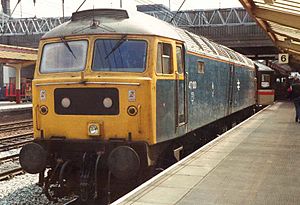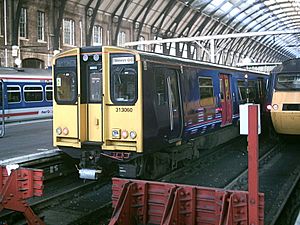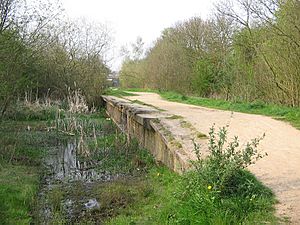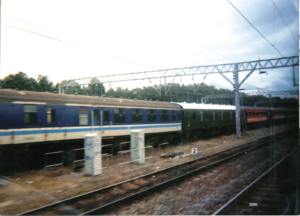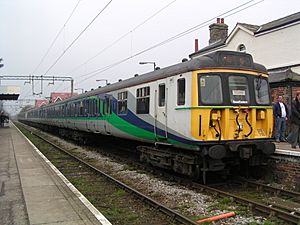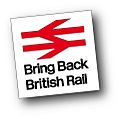British Rail facts for kids
British Rail (BR) was the main railway company in Great Britain. It ran all the trains from 1948 to 1997. The government created British Rail by taking over all the smaller railway companies. This was done under a law called the Transport Act 1947. In 1997, the railways were sold back to private companies.
Contents
How British Rail Started
Railways in Great Britain
Before British Rail, there were four big railway companies in Britain. They were formed in 1923 after many smaller companies joined together. These four companies were:
- Great Western Railway (GWR)
- London, Midland and Scottish Railway (LMS)
- London and North Eastern Railway (LNER)
- Southern Railway (SR)
After World War II, the railways were in bad shape. Many trains, buildings, and equipment were damaged. The government decided to take control of public transport, including the railways. This was part of a plan by Clement Attlee's Labour government. The Transport Act 1947 made this happen.
Railways in Northern Ireland
In Northern Ireland, the Ulster Transport Authority (UTA) ran the railways from 1948 to 1966. After that, Translink took over, calling them NI Railways. The governments of Northern Ireland and Ireland also ran the Great Northern Railway (Ireland) together for a while. Many lines in the west of Northern Ireland closed in the 1960s.
Modernizing the Railways
The 1955 Modernisation Plan
In 1955, the government approved a huge plan to update the railways. It cost £1.2 billion. During this time, many changes happened:
- Steam trains were slowly removed by 1968.
- Diesel trains and electric trains took their place.
- About a third of the railway network was closed. This was due to a report called the Beeching report in the 1960s.
A big survey in 1961 helped create the Reshaping of British Railways report. It suggested closing a third of all passenger lines and over 4,000 stations.
British Rail also started a brand called InterCity in 1966. This was for their fast, long-distance passenger services. The number of passengers went down until the late 1970s. But it grew a lot after the InterCity 125 high-speed trains were introduced.
Before 1982, British Rail was divided into regions, especially around London. This caused some problems. So, in 1982, British Rail changed how it was organized. All commuter services became one group. InterCity handled express services, and Regional Railways managed regional services.
British Rail built many steam locomotives between 1948 and 1960. But they decided to stop using steam trains completely by 1968. The "Modernisation Plan" aimed to make the railways faster, safer, and more reliable. It also wanted to attract more passengers and freight. Key parts of the plan included:
- Adding electric lines, especially in the east, Kent, Birmingham, and Scotland.
- Replacing steam trains with diesel trains.
- Getting new trains for passengers and freight.
- Improving signals and tracks.
- Closing a few lines, stations, and depots that were not needed.
Some long-distance train services were cut back from 1958 onwards. By 1965, freight services also ended on some lines. A large part of the Great Central Railway closed because of the Beeching axe.
New Diesel Trains
Some early diesel trains had problems, but many later models worked very well. The British Rail Class 127 diesel trains ran services from Marylebone to places like High Wycombe and Aylesbury.
The British Rail Class 47 diesel-electric locomotives were built in the 1960s. They were very reliable and some are still working today. The British Rail Class 52 diesel-hydraulic locomotives were built between 1961 and 1964. They were nicknamed Westerns. The British Rail Class 207 diesel-electric units were built in 1962 and were very versatile.
New Electric Trains
Like the diesels, some early electric trains had issues, but later ones were much better. The British Rail Class 423 electric trains were built from 1967 to 1974. They had doors next to every seat row. They were used for services in South London, Kent, and Sussex.
The British Rail Class 303 electric trains were known as Blue Train units because of their color. They were first used in 1960 in Strathclyde. The British Rail Class 73 locomotives were special because they could run on electric power or use a diesel engine.
The British Rail Class 86 was a standard electric locomotive built in the 1960s. It was designed after testing earlier models. The British Rail Class 312 electric trains were built from 1966 to 1974. They were the last trains built with the British Railways Mark 2 body and slam doors.
The British Rail Class 313 electric trains were built from 1976 to 1977. They were the first "second-generation" electric trains for British Rail. They could use two different types of electric power. They were also the first in Britain to have fully automatic couplers, making it easier for drivers to connect trains.
The Beeching Report
In the late 1950s, the railways continued to struggle. The government limited how much British Rail could spend. The government suggested that many services could be run more cheaply by buses. They said that most closed rail services would be replaced by bus routes. Only main lines would stay untouched.
Lord Beeching, a business expert, thought South Wales was a struggling industrial area. So, it lost most of its railway network. However, since 1983, the region has seen a big railway comeback, with new stations opening.
Some stations that closed in the 1960s have reopened years later. For example, Laurencekirk station closed in 1967 but reopened in 2009.
The Beeching report also suggested that British Rail should electrify some main lines and use containers for freight instead of old, expensive wagons. Some of these ideas were used later, like creating the Freightliner service.
Since the Beeching cuts, road traffic has grown a lot, causing congestion. Also, in recent years, more people are using trains than ever before. Because of this, some railway closures have been reversed. Many closed stations have reopened, and passenger services have returned to lines where they were stopped.
A notable reopening was the Robin Hood Line in Nottinghamshire in the early 1990s. Before it reopened, Mansfield was the largest town in Britain without a railway station.
The Serpell Report
In the early 1980s, railway profits started to drop. In 1983, Sir David Serpell, a government official, wrote the Serpell Report. He wanted even more railway cuts. There were plans to close Marylebone and send trains to Paddington. But these plans were dropped because they were not practical.
Pacer and Sprinter Trains
Because British Rail had less money, they created cheaper Pacer trains. The British Rail Class 143 diesel trains were introduced between 1985 and 1986. They were made using bus parts on a lorry chassis with train wheels. Early models had problems, but later ones were better.
The British Rail Class 156 "Super-Sprinter" diesel trains were built from 1987 to 1989. They replaced older trains. As funding increased before privatization, the successful British Rail Class 158 Express Sprinter trains were built from 1989 to 1992.
The Clapham Junction Crash
On 12 December 1988, three commuter trains crashed near Clapham Junction in London. 35 people died and over 100 were hurt. It was found that British Rail's old Mark 1 carriages were unsafe. Also, broken signalling equipment was a cause. After the crash, the signaling was fixed and improved.
Privatization
The British government under John Major decided that selling the railways to private companies would improve passenger services. This happened in 1997.
Since privatization, some lines have reopened. The Scottish Assembly Government reopened lines between Hamilton and Larkhall, and Alloa and Stirling. They are also working on a link from Airdrie to Bathgate. The biggest project is reopening the Waverley Line from Edinburgh to the Borders.
The Welsh Assembly Government reopened the Vale of Glamorgan Line in 2005 and the Ebbw Valley Line in 2008. Some English stations like Corby and Mansfield also reopened after privatization.
Train fares generally cost more than they did under British Rail.
How British Rail Was Split Up
For privatization, British Rail was divided into different parts. Regional Railways was one of these parts. It stopped running in 1996. The InterCity trains were split into several companies.
Since privatization, the number of train companies has changed many times. Here are some of the companies that took over passenger rail services:
| Railway working area | Location | Company |
|---|---|---|
| Midland Mainline | East Midlands | East Midlands Trains |
| Great North Eastern Railway | East Coast | East Coast operator |
| Virgin CrossCountry | Cross country and InterCity trains | CrossCountry |
| ScotRail | Scotland | First ScotRail (now called ScotRail Scotland's Railway) |
| Great Western Trains | South Wales, Wessex and the Thames Valley | First Great Western |
| Wales and West | Wales and Wessex (The West Country) | First Great Western and Arriva Trains Wales |
| Arriva Trains Northern | North East England and Yorkshire | First TransPennine Express and Northern Rail |
| First North Western | North West England and North Wales | First TransPennine Express and Northern Rail |
| Chiltern Railways | North West London, western Hertfordshire, Buckinghamshire, Coventry and Birmingham | Chiltern Railways |
| Silverlink | east and north London; western Hertfordshire, Buckinghamshire, Bedfordshire, Northamptonshire, Coventry and Birmingham | London Overground and London Midland |
| West Anglia Great Northern (WAGN) | in North London North East London, East Anglia and eastern Hertfordshire | split between First Capital Connect and National Express East Anglia |
| Great Eastern | in East London, North East London, Essex and Suffolk | now part of National Express East Anglia |
| Anglia Railways | East London North East London and East Anglia | Now part of 'One Railway' (now renamed National Express East Anglia) |
| Thameslink | South London, North London, Bedfordshire, central Hertfordshire, Cambridgeshire, West Sussex and Surrey | First Capital Connect |
| Thames Trains | West London, Wessex and the Thames Valley | First Great Western |
| LTS | East London and south Essex | c2c |
| Connex South Eastern | South East London, Kent and Sussex | South Eastern Trains then Southeastern |
| Gatwick Express | London Victoria Station to Gatwick Airport | Southern |
| Virgin Trains (West Coast) | West Coast | Virgin Trains |
| Connex South Central | Surrey, Sussex, the South Coast and South London | Southern |
| Merseyrail Electrics | Merseyside | Arriva Trains Merseyside |
| South West Trains | in South West London, Surrey, Berkshire, Hampshire, Sussex and the West Country | South West Trains |
| Island Line | in the Isle of Wight | South West Trains |
| Central Trains | The English Midlands and Central Wales | London Midland Cross Country and East Midlands Trains |
| Waterloo & City line | The Waterloo & City line | London Underground took over this short underground line. |
| Express Parcels Services | Nationwide | Parcels and railway postal services of the Royal Mail. |
| Essex Express | South Essex | c2c |
| Load-Haul | Nationwide | Freight |
| Freightliner | Nationwide | Freight |
| Rail Express Systems | Nationwide | Mail and railway postal services of the Royal Mail. |
| Trainload Freight | Nationwide | Freight |
| Railfreight Distribution | Nationwide | Freight |
| Trans-Rail | Nationwide | Freight |
| Mainline Freight | Nationwide | Freight |
| SeaLink Ferries | Nationwide | Ferry ships to places like the Isle of Wight. |
The British Rail Logo
The British Rail "double arrow" logo looks like two arrows pointing in opposite directions. People sometimes called it "the arrow of indecision". Today, this logo is used on street signs in Great Britain to show railway stations. It is also printed on train tickets as part of the National Rail brand.
Worker Relations
Sometimes, British Rail staff went on strike because of disagreements over pay, safety, and working hours. There were several strikes in the late 1970s. After privatization, the number of strikes went down.
Gallery
Images for kids
See also
 In Spanish: British Rail para niños
In Spanish: British Rail para niños



